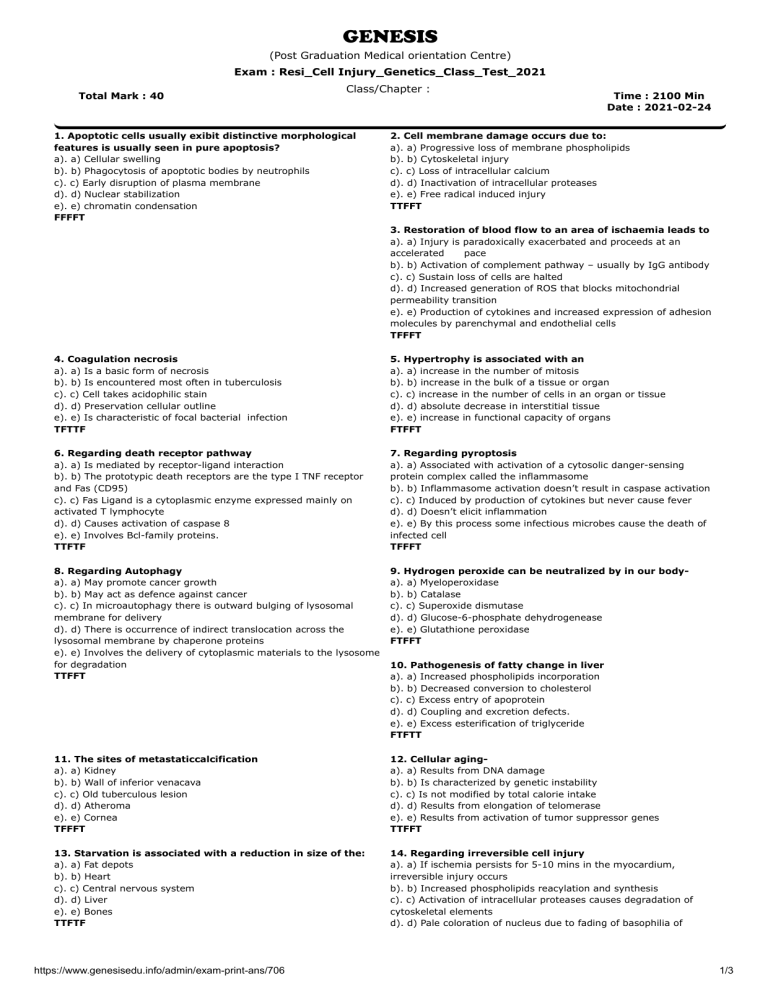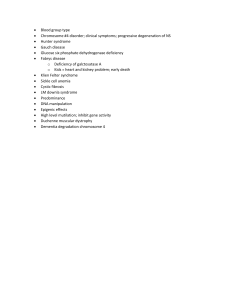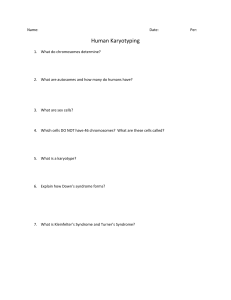
GENESIS (Post Graduation Medical orientation Centre) Exam : Resi_Cell Injury_Genetics_Class_Test_2021 Total Mark : 40 Class/Chapter : 1. Apoptotic cells usually exibit distinctive morphological features is usually seen in pure apoptosis? a). a) Cellular swelling b). b) Phagocytosis of apoptotic bodies by neutrophils c). c) Early disruption of plasma membrane d). d) Nuclear stabilization e). e) chromatin condensation FFFFT Time : 2100 Min Date : 2021-02-24 2. Cell membrane damage occurs due to: a). a) Progressive loss of membrane phospholipids b). b) Cytoskeletal injury c). c) Loss of intracellular calcium d). d) Inactivation of intracellular proteases e). e) Free radical induced injury TTFFT 3. Restoration of blood flow to an area of ischaemia leads to a). a) Injury is paradoxically exacerbated and proceeds at an accelerated pace b). b) Activation of complement pathway – usually by IgG antibody c). c) Sustain loss of cells are halted d). d) Increased generation of ROS that blocks mitochondrial permeability transition e). e) Production of cytokines and increased expression of adhesion molecules by parenchymal and endothelial cells TFFFT 4. Coagulation necrosis a). a) Is a basic form of necrosis b). b) Is encountered most often in tuberculosis c). c) Cell takes acidophilic stain d). d) Preservation cellular outline e). e) Is characteristic of focal bacterial infection TFTTF 5. Hypertrophy is associated with an a). a) increase in the number of mitosis b). b) increase in the bulk of a tissue or organ c). c) increase in the number of cells in an organ or tissue d). d) absolute decrease in interstitial tissue e). e) increase in functional capacity of organs FTFFT 6. Regarding death receptor pathway a). a) Is mediated by receptor-ligand interaction b). b) The prototypic death receptors are the type I TNF receptor and Fas (CD95) c). c) Fas Ligand is a cytoplasmic enzyme expressed mainly on activated T lymphocyte d). d) Causes activation of caspase 8 e). e) Involves Bcl-family proteins. TTFTF 7. Regarding pyroptosis a). a) Associated with activation of a cytosolic danger-sensing protein complex called the inflammasome b). b) Inflammasome activation doesn’t result in caspase activation c). c) Induced by production of cytokines but never cause fever d). d) Doesn’t elicit inflammation e). e) By this process some infectious microbes cause the death of infected cell TFFFT 8. Regarding Autophagy a). a) May promote cancer growth b). b) May act as defence against cancer c). c) In microautophagy there is outward bulging of lysosomal membrane for delivery d). d) There is occurrence of indirect translocation across the lysosomal membrane by chaperone proteins e). e) Involves the delivery of cytoplasmic materials to the lysosome for degradation TTFFT 9. Hydrogen peroxide can be neutralized by in our bodya). a) Myeloperoxidase b). b) Catalase c). c) Superoxide dismutase d). d) Glucose-6-phosphate dehydrogenease e). e) Glutathione peroxidase FTFFT 11. The sites of metastaticcalcification a). a) Kidney b). b) Wall of inferior venacava c). c) Old tuberculous lesion d). d) Atheroma e). e) Cornea TFFFT 12. Cellular aginga). a) Results from DNA damage b). b) Is characterized by genetic instability c). c) Is not modified by total calorie intake d). d) Results from elongation of telomerase e). e) Results from activation of tumor suppressor genes TTFFT 13. Starvation is associated with a reduction in size of the: a). a) Fat depots b). b) Heart c). c) Central nervous system d). d) Liver e). e) Bones TTFTF 14. Regarding irreversible cell injury a). a) If ischemia persists for 5-10 mins in the myocardium, irreversible injury occurs b). b) Increased phospholipids reacylation and synthesis c). c) Activation of intracellular proteases causes degradation of cytoskeletal elements d). d) Pale coloration of nucleus due to fading of basophilia of https://www.genesisedu.info/admin/exam-print-ans/706 10. Pathogenesis of fatty change in liver a). a) Increased phospholipids incorporation b). b) Decreased conversion to cholesterol c). c) Excess entry of apoprotein d). d) Coupling and excretion defects. e). e) Excess esterification of triglyceride FTFTT 1/3 chromatin e). e) Membrane damage is the central factor in the pathogenesis FFTTT 15. Squamous metaplasia occurs in: a). a) Colon b). b) Cervix c). c) Uterus d). d) Prostate e). e) Pleura FFTTF 16. The following diseases are due to increased apoptosis a). a) Auto immune disorders b). b) Spinal muscular atrophy c). c) AIDS d). d) Myocardial infarction e). e) Viral hepatitis FFTTT 17. Caspase dependent mechanisms are-a). a) Extrinsic pathway of apoptosis b). b) Intrinsic pathway of apoptosis c). c) Necroptosis d). d) Necrosis e). e) Pyroptosis TTFFT 18. Examples of diseases caused by misfolding of proteins-a). a) Alpha-1 antitrypsin deficiency b). b) Creutzfeldt- Jacob disease c). c) Familial hypercholesterolemia d). d) Retinitis pigmentosa e). e) Tay-Sachs disease TTTTT 19. Causes of cell injury are-a). a) Autoimmune reactions b). b) Extremes of temperature c). c) Genetic defects d). d) Nutritional excess e). e) Worm infections TTTTT 20. Pro-apoptotic proteins are— a). a) BAK b). b) BAX c). c) BCL-2 d). d) BCL-XL e). e) MCL-2 TTFFF 21. Followings are genetically transmitted diseases; a). a) Huntington’s chorea b). b) Wilson’s disease c). c) Multiple sclerosis d). d) Parkinson’s disease e). e) Myotonia dystrophica TTFFT 22. Characteristics of autosomal dominant a). a) Both parents affected b). b) There is full penetrance & acceptance of gene c). c) Homozygous gene show phenotype d). d) Vertical transmission e). e) High new mutation rate FFFFT 23. Autosomal recessive diseases a). a) Are transmitted on 50% of offspring b). b) Remains as carrier in 50% of offspring c). c) Complete penetrance is common d). d) Increase risk of disease among offspring of consunquineous marriage e). e) Are more common among female children FTTTF 24. The following statements are correct regarding X- linked recessive trait a). a) The trait manifests only in males. b). b) The gene responsible for the condition is transmitted from an affected man to all his daughters. c). c) The gene is never transmitted directly from father to son. d). d) A carrier female will transmit the condition to 25% of her sons. e). e) Normal offspring may be produced if mating occurs between an affected male and a carrier female. FTTFT 25. Which of the following genetic disorders are inherited as X linked recessive? a). a) Neurofibromatosis b). b) Haemophilia A c). c) Phenyl Ketonuria d). d) Duchenne Muscular dystrophy e). e) Glucose 6-phosphate dehydrogenese deficiency FTFTT 26. Following are true statements regarding chromosome disorders-a). a) In Fragile X syndrome, the triplet repeat does not change in size significantly when passed from father to daughter. b). b) Fragile X syndrome is a single well defined condition. c). c) Girls with bilateral inguinal hernia should have their chromosomes tested. d). d) Normal karyotyping is a good way of diagnosing Fragile X syndrome in girls. e). e) Microarray-CGH analysis will detect genetic imbalances in approximately 50% children with neurodevelopmental disorders. TFTFF 27. Down’s syndrome: a). a) Has an incidence of 1:700 b). b) Is associated with the age of the mothers c). c) Mosaicism accounts for 2% of all Down’s syndrome d). d) Is more accurately diagnosed in pregnant woman with amniocentesis than hormonal tests e). e) Is associated with congenital glaucoma TTTTF 28. Turner’s syndrome is characterized by a). a) 45 XY chromosomal abnormality b). b) Secondary amenorrohea c). c) Coarctation of the aorta d). d) Multicystic ovary e). e) Absence of pubic hair FFTFF 29. True statements include: a). a) RNA can be studied by PCR (Polymerase chain reaction), It has to be translated into complementary DNA b). b) Western blotting is used to detect specific protein in a mixture of protein. c). c) Northern blotting is used to detect DNA sequence d). d) Southern blotting is primarily used to detect DNA sequence e). e) Gel electrophoresis is used in both Southern and Northe rn https://www.genesisedu.info/admin/exam-print-ans/706 2/3 blotting TTFTT 30. Prenatal diagnosis is done in the following cases-a). a) Congenital hypothyroidism b). b) Neural tube defect c). c) G6PD deficiency d). d) Common variable immunodeficiency e). e) Thalassaemia FTTFT 31. In mitochondrial genetics a). a) Heteroplasmy refers to the presence of more than one mutation in mitochondria. b). b) Mitochondrial genes mutate less often than nuclear genes. c). c) Mitochondrial conditions affect only muscle and nerve tissue. d). d) The risk of passing a mitochondrial condition to the next generation may be as high as 100% e). e) Mitrochondrial diseases have nothing to do with nuclear genes. FFFTF 32. Examples of chromosomal deletiona). a) Retinoblastoma b). b) Squamous cell carcinoma of the lung c). c) Colorectal carcinoma d). d) Multiple endocrine neoplasia type 2A e). e) Papillary carcinoma of the thyroid TFTTF 33. Examples of trinucleotide repeat expansion disease a). a) Fragile X syndrome b). b) Cystic fibrosis c). c) Duchenne’s muscular dystrophy d). d) Myotonic dystrophy e). e) Friedreich’s ataxia TFFTT 34. Defects with structural protein synthesis are associated with: a). a) Down syndrome b). b) Hereditary spherocytosis c). c) Marfan syndrome d). d) Klinefelter syndrome e). e) Osteogenesis imperfecta FTTFT 35. Point mutations occur in a). a) Cystic fibrosis b). b) Alpha 2 antitrypsin deficiency c). c) Haemochromatosis d). d) Hereditary motor and sensory neuropathy type- 1 e). e) Achondroplasia FTTFT 36. Properties of genetic code? a). a) Specific codes always cedes for different amino acid b). b) Genetic code is universal without any minor exceptions. c). c) Redundancy is sometimes called degenerate d). d) Comma less and overlapping e). e) It is read from a fixed starting point FFTFT 37. Indications for Barr body count a). a) Inguinal mass in male b). b) Severe hypospadias c). c) Infertility of male d). d) Lymphoedema in male newborn e). e) Stigmata of turner’s syndrome FTTFT 38. Autosomatdominat disordersa). a) Hereditary hemorrhagic telangiectasia b). b) Brigade’s syndrome c). c) Gilbert’s syndrome d). d) Homocystinuria e). e) Neurogenic muscular atnephy TTFFF 39. Metabdic disorders of AR disordersa). a)Phenylketonuria b). b)Nephrogenic diabetes incipidus c). c)Glucone-6-P dehydnoginane deficiency d). d)Familial Hypercholesterolimia e). e)Glycogen storage disease TFFFT 40. When a hemophilic male marries a carrier femalea). a) All of their son will be affected b). b) Half of their son will be carriers c). c) Half of their daughter will be carriers d). d) There will be no affected daughters e). e) Half of their non will be healthy FTFTF https://www.genesisedu.info/admin/exam-print-ans/706 3/3


